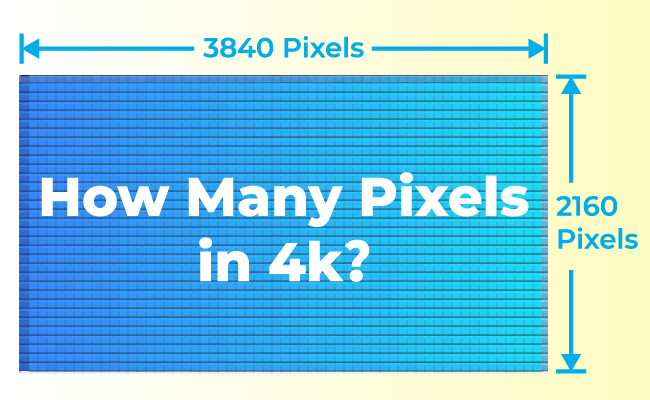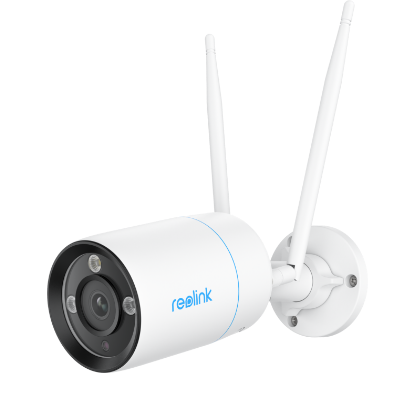How Many Pixels is 4K Resolution: Clarity Unveiled

When it comes to high definition, 4K’s exceptional clarity and stunning detail is head and shoulders above the rest. If you’ve ever wondered where that clarity comes from, or exactly how many pixels are packed into a 4K display, don't miss this article. Here, we’ll explore the secrets behind 4K and delve into the precise pixel count that fuels its visual brilliance.
How Many Pixels/Megapixels Is 4K?
4K resolution is a display and video standard defined by a horizontal resolution of roughly 4,000 pixels, used to measure how sharp and detailed an image appears on a screen. Under the common Ultra High Definition (UHD) format, 4K has pixel dimensions of 3840 × 2160, which equals approximately 8.3 megapixels, or about 8.29 million total pixels.
4K Resolution Explained: Get a clear explanation of what resolution is 4K.
When Was 4K Resolution First Developed?
4K technology dates back to 1984, when the GPU ARTC HD63484 successfully created monochrome images in 4K resolution. Seventeen years after that early-stage technology, the IBM T220/T221 screen is capable of displaying 4K content was introduced.
Following this innovation, many universities researched and refined the 4K format, and in 2010 4K cameras started being produced by top media and display manufacturers. This led to the format’s wider usage and adoption, and the technology became even more popular after streaming websites like YouTube began supporting 4K resolutions.
Eventually, 4K made its way into cinemas and movie theaters, offering audiences a stunning visual experience.
Comparing 4K to Other Resolutions
4K resolution contains approximately 3840 pixels horizontally and 2160 pixels vertically. Multiplying these values delivers a total of 8,294,400 pixels, which is commonly rounded up to either 8.3 million pixels or 8.3 megapixels.
The chart below, which compares 4K resolution to other commonly used resolutions makes its advantages clear.

4K vs 8K:
While 8K’s delivery of four times 4K’s resolution result in sharper images with more detail, 8K displays are significantly more expensive and have limited content availability.
4K vs. 8K: A detailed breakdown of the distinctions between 4K and 8K resolutions.
4K vs 5K:
5K offers sharper and more detailed images due to its higher pixel density, but the difference is most noticeable on larger screens, and their displays require more powerful hardware for running applications. This advanced technology also makes them more expensive than 4K.
4K vs. 5K: Learn about the nuances between 4K and 5K resolutions and when each might be ideal.
4K vs 1440p:
While 1440p can still be appreciated on smaller screens and has the advantage of requiring less processing power and higher refresh rates that offer smoother motion, 4K provides sharper and more detailed images. 4K’s higher pixel density also provides more accurate and vivid colors. This is most noticeable at closer viewing distances.
4K vs 1080p:
4K delivers four times the pixel count that 1080p does, and offers finer details and sharper images. While 4K displays can enhance the appearance of non-4K content, opting for a 4K display ensures compatibility with newer content and avoids the need for upgrades in the future.
4K vs 3440 x 1440:
Though 4K offers higher pixel density and greater resolution, 3440 x 1440 is an ultrawide format that is ideal for immersive gaming and multimedia experiences, and many games and media applications offer ultrawide support. Still, 4K content is widely available, where 3440 x 1440 content has more limited availability.
4K vs 5MP:
4K offers higher pixel density and sharper images than 5MP, has wider content compatibility and is suitable for video playback, gaming, and professional video editing. 5MP is most commonly used in surveillance cameras and for specific professional applications.
4K vs. 5MP: Discover the differences between 5MP and 4K resolutions in security camera systems.
4K Resolution Size And How They Impact Different Devices
The size of 4K affects pixel count on different devices in unique ways. Below we’ll explore popular examples across various platforms.
How many pixels in a 4K monitor?
4K monitors have the same number of pixels as 4K televisions and cameras, but the impact of pixel count on a monitor’s display will vary based on other factors, including screen size and viewing distance. Larger monitors benefit more from higher pixel counts, as the increased resolution is more apparent.
How many pixels in a 4K TV?
A 4K television typically has a resolution of 3840 pixels horizontally by 2160 pixels vertically, resulting in a total of approximately 8.3 million pixels. Though this resolution is consistent across different screen sizes in the 4K category, pixel density can vary depending on screen size.
A 50-inch television with 4K resolution has a higher pixel density than an 80-inch unit with the same resolution. The smaller television screen packs the same number of pixels into a smaller area, resulting in a sharper image.
How many pixels in a 4K security camera?
4K cameras capture images and videos at a resolution of 3840 x 2160 pixels. This is the same resolution as that provided by 4K televisions and monitors.
If you want a higher quality photographic image, choosing the higher number of pixels provided by a 4K camera is the better choice, though image quality is influenced by other factors including the quality of the camera's sensor, lens, and image processing algorithms.
If you’re looking for 4K security cameras, following 4K Wi-Fi6 security cameras are excellent choices.
Reolink E1 Outdoor Pro is a 4K Wi-Fi6 PTZ security camera. With an impressive 4K 8MP resolution, this camera provides clear video footage, ensuring detailed monitoring. The Wi-Fi 6 connectivity goes beyond high-speed wireless performance, offering a robust and stable connection that minimizes disruptions in your surveillance feed.
Additionally, the intelligent Auto Tracking feature automatically follows and records moving objects, enhancing the camera's overall surveillance capabilities.
4K WiFi PTZ Camera with Auto-Tracking
4K 8MP Super HD, Smart Person/Vehicle Alerts, 355° Pan & 50° Tilt & 3X Optical Zoom, Auto Tracking, Color Night Vision.
Reolink RLC-810WA is a 4K Wi-Fi 6 color night security camera. With its 4K 8MP Ultra HD resolution, this WiFi 6 camera provides unparalleled clarity for detailed monitoring. The incorporation of Dual-Band WiFi 6 ensures not only faster speeds but also higher stability, guaranteeing a reliable and robust connection. Experience enhanced nighttime visibility with Color Night Vision, allowing for clear imaging even in low-light conditions.
4K WiFi 6 Surveillance Camera
4K 8MP Ultra HD, Dual-Band WiFi 6, Color Night Vision, IP67 Waterproof, Smart Detection, Two-Way Audio, Built-in Siren.
Reolink RLK16-1200DB4-A is an all-powerful 4K security kit featuring next-gen PoE technology. With stable wied connection, this kit ensures high-performance connectivity. The 12MP Ultra HD resolution guarantees clear video footage, providing sharp and detailed monitoring.
Notably, the system includes advanced person, vehicle, and animal detection capabilities, enhancing its ability to discern and alert you to specific activities. The 16-channel NVR, equipped with a 2TB HDD, offers ample storage for extended footage retention.
12MP PoE Security System with Color Night Vision
12MP Ultra HD, Person/Vehicle Detection, Power over Ethernet, 16-Channel NVR.
How Many Pixels in Reolink 16MP Security Cameras?
Reolink has consistently pushed the boundaries of high-end security cameras by offering higher resolutions, exemplified by the 16MP model, Duo 3 PoE. This dual-lens model boasts a total of 16 million pixels, with 7680 pixels horizontally and 2160 pixels vertically. It provides nearly twice the clarity of 4K resolution. Whether for indoor or outdoor surveillance, this camera delivers effective monitoring capabilities.
Groundbreaking 16MP Dual-Lens PoE Camera
16MP UHD, Dual-Lens, Motion Track, 180° Wide Viewing Angle, Power over Ethernet, Color Night Vision.
Additionally, Reolink Duo 3 Wi-Fi also offers 16MP resolution, delivering incredibly sharp and detailed images. The advanced Wi-Fi 6 connectivity enhances its versatility, allowing for seamless setup and remote access from your smartphones or tablets.
Groundbreaking 16MP Dual-Lens WiFi Camera
16MP UHD, Dual-Lens, Motion Track, 180° Wide Viewing Angle, Plug-In WiFi, Color Night Vision.
FAQs
Is 4K or 12MP better?
12MP delivers greater detail, making it ideal for still images or situations that require heavy cropping, since it contains more pixels than 4K’s 8.3MP. 4K resolution, however, remains highly capable, offering sharp detail for most video applications while using less storage and bandwidth.
How many megapixels is 2K?
2K resolution typically equals about 3.7 to 4 megapixels, most often referring to a display size of 2560 × 1440 pixels. This resolution contains exactly 3,686,400 total pixels and is commonly rounded to 4MP for simplicity in marketing and product descriptions.
Is 50 megapixels 4K?
No, 50 megapixels is far higher than 4K resolution. A standard 4K UHD frame measures 3840 × 2160 pixels, which equals about 8.3 megapixels, whereas a 50MP image typically has dimensions around 8688 × 5792 pixels.
How Many Pixels In 4K Videos?
4K video is a video resolution that’s commonly used in display devices and for content creation. It offers a higher level of detail and clarity than lower-resolution formats. Its resolution is 3840 pixels horizontally by 2160 pixels vertically, which is frequently referred to as 2160p or UHD (Ultra High Definition). Multiplying these two numbers provides a total of 8,294,400 pixels.
To understand the impact of 4K video, imagine a grid consisting of 3840 columns and 2160 rows of tiny, individual dots. These are known as pixels, and each pixel represents a single unit of color that contributes to the overall image displayed on the screen. The more pixels there are in a given area, the sharper and more detailed the image will be.
Conclusion
4K resolution has revolutionized the way we experience visual content. With their impressive pixel count, 4K displays offer unparalleled clarity and detail, bringing even the smallest elements of an image or video to life. Whether you are gauging the quality of a camera or a visual display, understanding pixel count is crucial to ensuring the best viewing experience.
If you have other problems about 4K resolution, please comment below. We'd love to communicate with you.
Search
Subscribe for the Latest Updates
Security insights & offers right into your inbox





